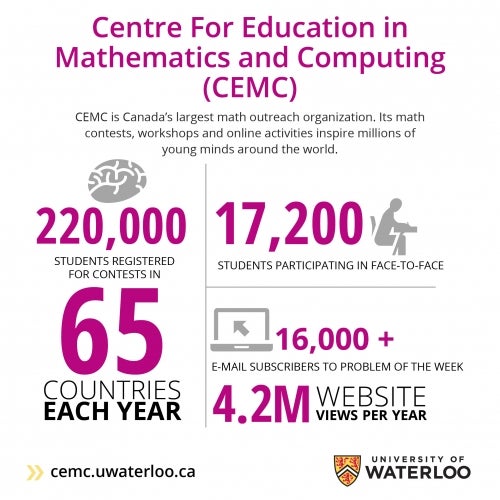
From Canada to China: Waterloo’s free math courseware goes global
Waterloo’s Grade 12 math courseware is now being used by students and teachers in almost 90 countries around the world

Waterloo’s Grade 12 math courseware is now being used by students and teachers in almost 90 countries around the world
By Heather Bean Marketing and Strategic CommunicationsOnly one semester after its launch, the University of Waterloo’s new Grade 12 online math courseware is already being used by students and teachers in almost 90 countries - everywhere from Russia and China to the U.S. and Germany.
“We are thrilled to see the rapid spread of our courseware, and are glad that teachers and students are making use of it,” says Ian VanderBurgh, director of Waterloo’s Centre for Education in Mathematics and Computing (CEMC).
Closer to home, at a high school in Milton, Ontario, the free courseware is helping to replace textbooks altogether.
“When you’re looking for math material on the Internet you have to weed it carefully,” says Vicki Randall, a math teacher at Craig Kielburger Seconday School. “But when it’s from the University of Waterloo you know it’s good.”
The online courses in precalculus and calculus have been designed by the University’s CEMC and Maplesoft, a subsidiary of Cybernet Systems Co. Ltd. in Japan. Maplesoft has over 25 years of experience developing products for technical education and research. More than 90 per cent of advanced research institutions and universities worldwide, including MIT, Stanford and Oxford, have adopted Maplesoft solutions. The University of Waterloo’s Centre for Extended Learning also played a vital role by combining the CEMC's content with Maplesoft's platform to create the final product.
The CEMC online materials include text, audio, self-assessment questions, exercises and solutions to support student learning, and enrichment problems to extend what was learned.
CEMC is Canada’s largest and best known outreach organization for math and computer science promotion. Recently, the Natural Sciences and Engineering Council of Canada (NSERC) honoured CEMC with a national award for promoting science and engineering.
The online courseware is just the latest initiative for CEMC, an organization with a long history of inspiring math students and supporting teachers. The CEMC’s annual math and computer science competitions engage students from around the world. In 2014-2015, more than 220,000 students registered for the contests at almost 3,000 schools in Canada and in 65 other countries.
“Creating online courseware seemed like a natural next step for us as it provides free, high-quality curriculum content and increased flexibility to teachers, students and administrators,” said VanderBurgh.
The vision is already playing out at Craig Kielburger Secondary School with mathematics and computer science teacher Sheri Hill’s move to a textbook-free class. It’s part of a push the school is making toward 21st century learning. “We want to let the students gather digital research and make discoveries on their own,” says Hill, who is a University of Waterloo alumna.
She says the CEMC’s offerings, stand out for their quality compared to the many online web resources. “They’re extremely useful,” says Hill. “The material is very organized and very professional. The amount of effort put in is amazing.”
Randall started using the CEMC coursework as soon as it came online in January. “I didn’t hand out textbooks at all. I’m just using the CEMC exercises for homework.”
Hill points out that the CEMC’s material fits naturally into a “flipped classroom”, another innovation of 21st century learning, in which students watch lectures on their own time and then perform traditional homework activities—like solving math problems—in the classroom, with the teacher on hand for discussion. To ensure all students have access to computers, the school library stocks Chromebooks to sign out.
Work is already underway to use the Maplesoft-developed platform in other online courses offered by the University of Waterloo, including core math courses, as well as courses in optimization, modeling, computer science, and quantum information systems.
“We’re looking forward to getting the other courses from Waterloo,” says Hill, who is keen to get a look at the Grade 12 computing courses set to release in September.

CEMC is Canada's largest math outreach organization. Its math contests, workshops and online activities inspire millions of young minds around the world.

Read more
Here are the people and events behind some of this year’s most compelling Waterloo stories

Read more
Meet the 14 exceptional students representing Waterloo’s newest grads

Read more
Meet the five exceptional graduate students taking the convocation stage as Class of 2024 valedictorians
The University of Waterloo acknowledges that much of our work takes place on the traditional territory of the Neutral, Anishinaabeg, and Haudenosaunee peoples. Our main campus is situated on the Haldimand Tract, the land granted to the Six Nations that includes six miles on each side of the Grand River. Our active work toward reconciliation takes place across our campuses through research, learning, teaching, and community building, and is co-ordinated within the Office of Indigenous Relations.